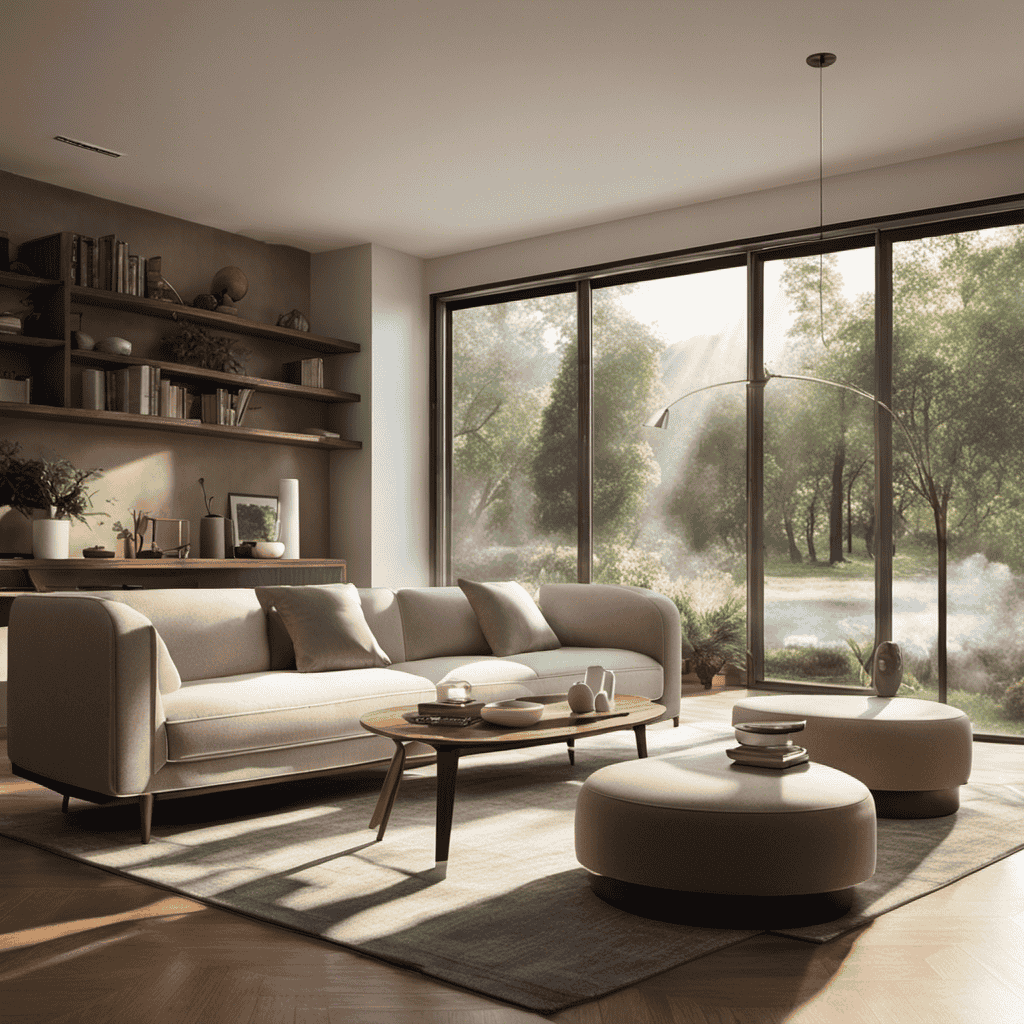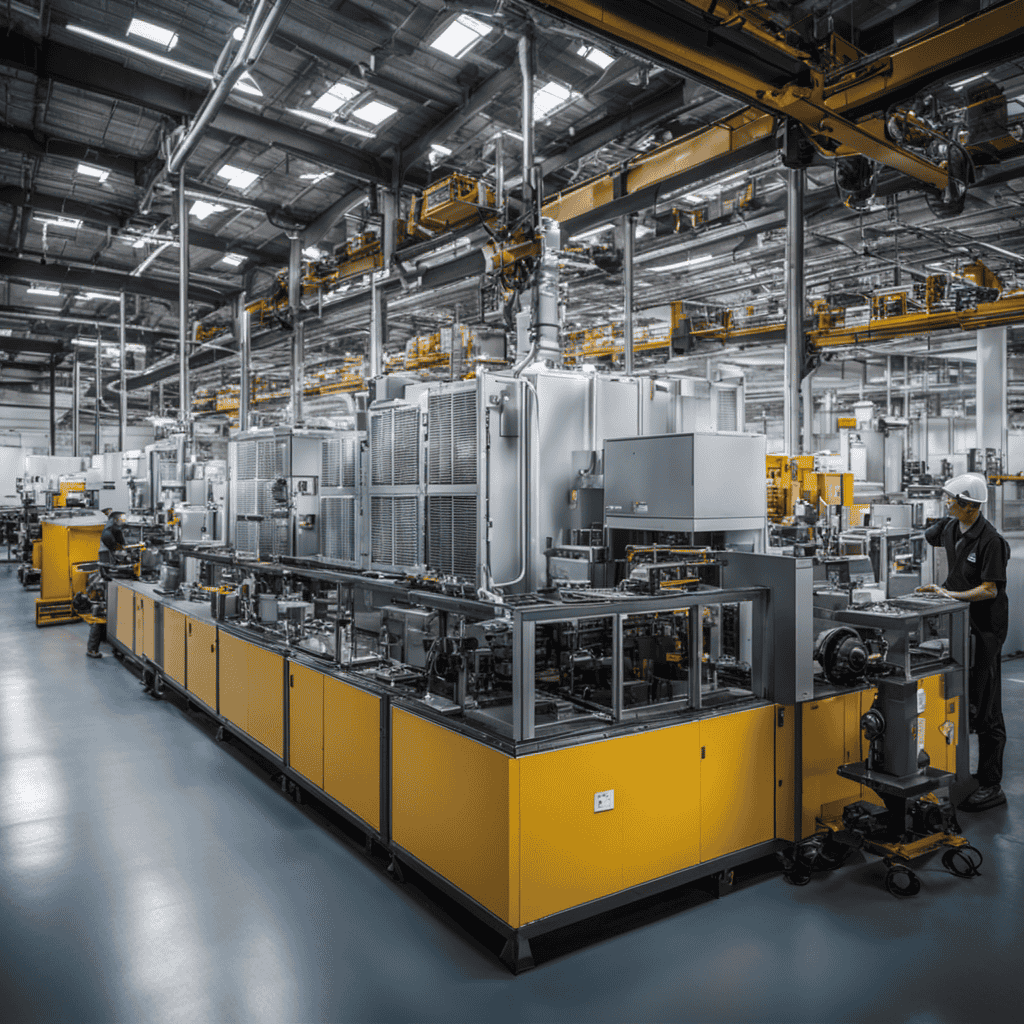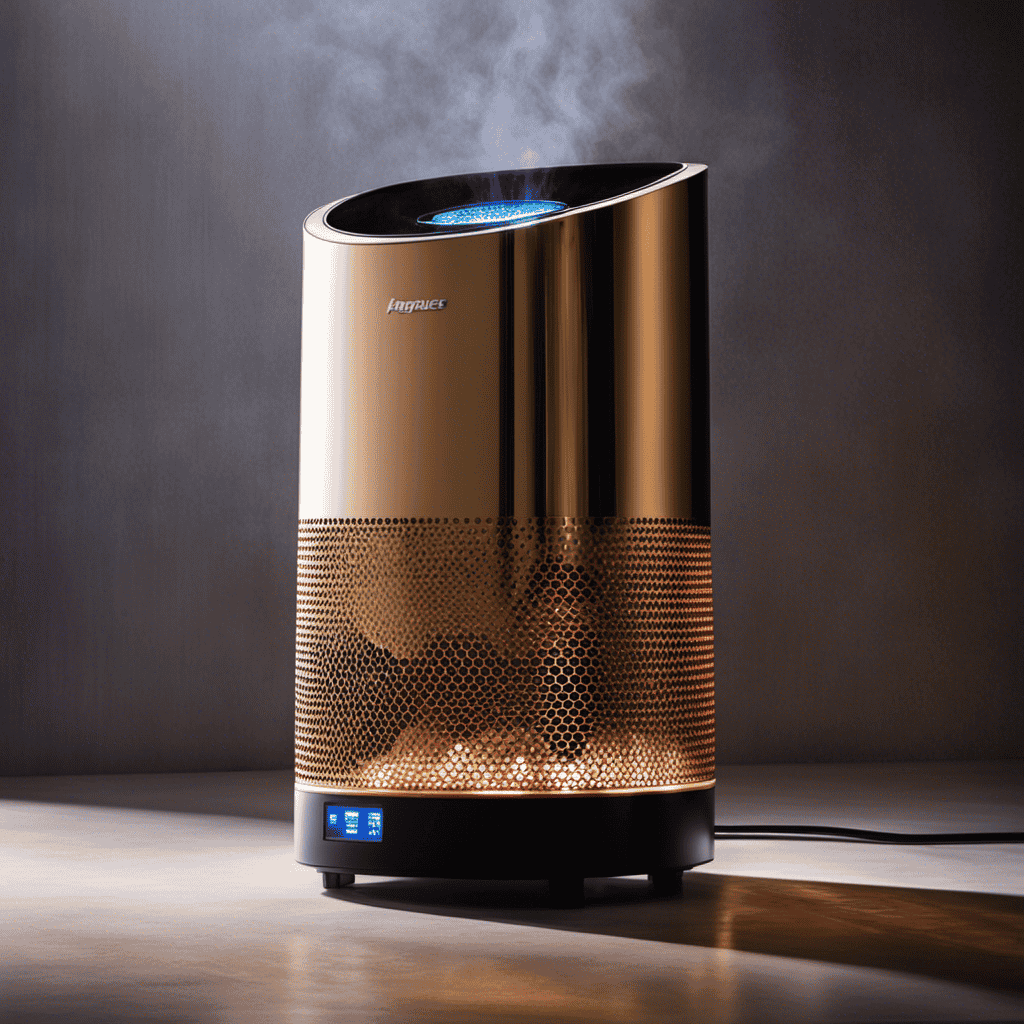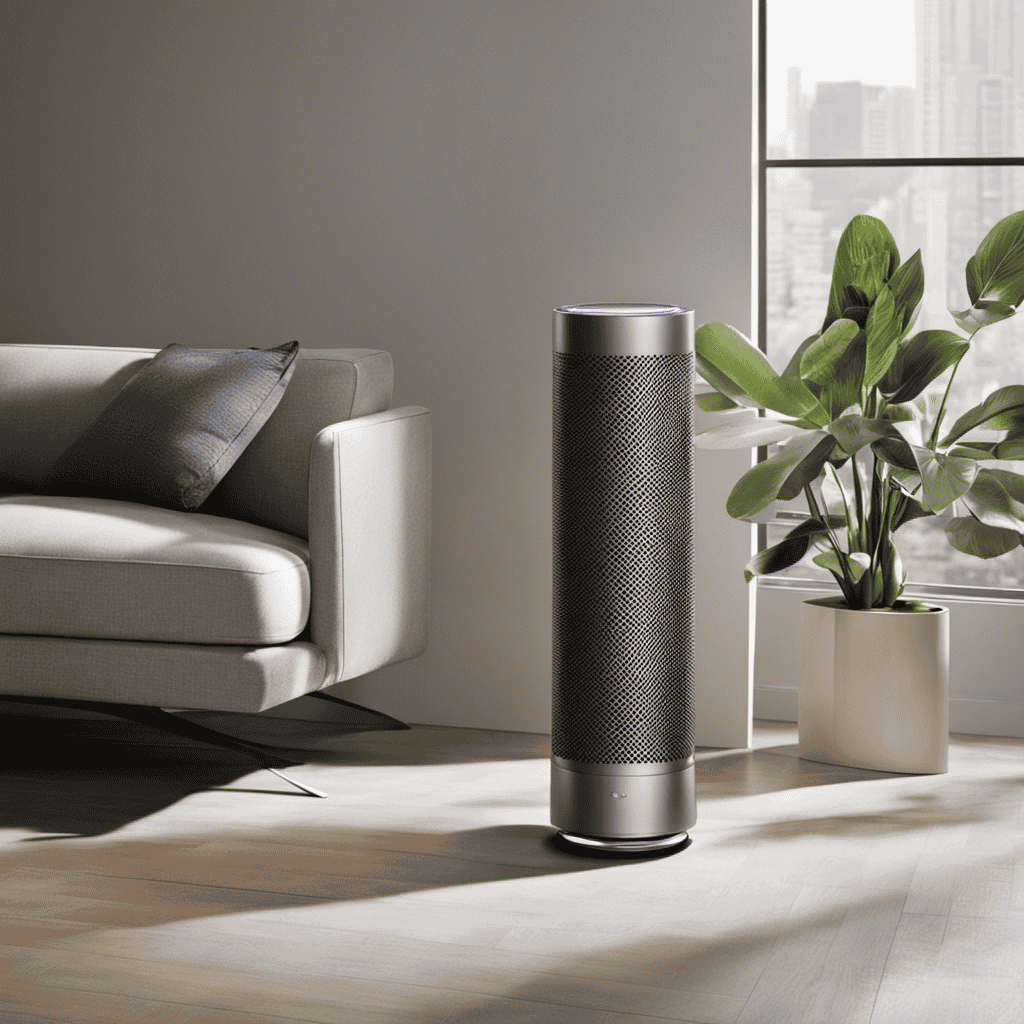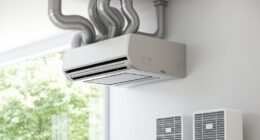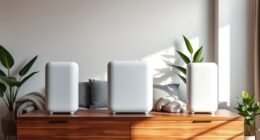I understand your question: “How long should I run my air purifier each day?” Let me explain the key factors to consider when deciding the best runtime for your air purifier.
In this article, I’ll dive into the benefits of running an air purifier daily, the recommended minimum runtime for effective air purification, and how to balance runtime with noise levels.
So, if you’re ready to breathe cleaner air and maximize the effectiveness of your air purifier, keep reading.
Key Takeaways
- The recommended minimum runtime for optimal air purification is a few hours daily, with continuous runtime providing consistent relief from allergens and maintaining clean air.
- Understanding the air purifier’s filtration capacity, including the CADR (Clean Air Delivery Rate) and proper maintenance, is crucial for efficient air filtration.
- Adjusting the air purifier runtime based on allergies involves running it for a few hours daily, regular maintenance, and adjusting settings according to room size and allergy severity.
- Balancing air purifier runtime with energy consumption, signs of overuse (such as increased allergy symptoms and dryness/irritation), and noise levels is important for optimal usage.
Benefits of Running an Air Purifier Daily
Running an air purifier daily can greatly improve indoor air quality. The recommended runtime for an air purifier varies depending on the size of the room and the level of pollution present. However, running it for at least 8 hours a day is generally recommended to achieve optimal results.
There are numerous health benefits associated with running an air purifier regularly. Firstly, it helps remove airborne particles such as dust, pollen, pet dander, and mold spores, which can trigger allergies and respiratory issues. Secondly, it reduces the concentration of volatile organic compounds (VOCs) and other harmful chemicals in the air, promoting a healthier living environment. Lastly, air purifiers also help eliminate unpleasant odors, making the indoor space more pleasant and inviting.
Overall, incorporating an air purifier into your daily routine can significantly enhance your overall well-being by improving the quality of the air you breathe.
Factors to Consider When Determining Air Purifier Runtime
Consider factors such as room size, air quality, and personal preferences when determining how much time to use your air purifier. To help you make an informed decision, here are four things to consider:
-
Room Size: Larger rooms may require a longer runtime to effectively purify the air. Smaller rooms, on the other hand, may need less time as the air circulation is quicker.
-
Air Quality: If you live in an area with high pollution or have respiratory issues, you may need to run the air purifier for longer periods to maintain clean air.
-
Personal Preferences: Some individuals may prefer to run the air purifier continuously, while others may choose to use it intermittently or during specific times of the day.
-
Adjusting Air Purifier Settings: Many air purifiers come with adjustable settings, allowing you to customize the runtime based on your needs. You can adjust the fan speed or set a timer to control the duration of operation.
When choosing the right air purifier, consider these factors to determine the optimal runtime for your specific circumstances.
Recommended Minimum Runtime for Optimal Air Purification
To maintain optimal air purification, it’s recommended to aim for a minimum runtime of at least a few hours daily. However, it’s important to note that the recommended maximum runtime is not specified, as running an air purifier continuously may not be necessary or beneficial in all situations.
Here is a comparison table outlining the benefits of continuous air purifier runtime versus shorter runtime periods:
| Continuous Runtime | Shorter Runtime |
|---|---|
| Consistently purifies air | Limited air purification |
| Removes pollutants | Less effective |
| Maintains clean air | Temporary improvement |
| Provides continuous relief | Temporary relief |
| Reduces allergens | Inconsistent results |
While continuous runtime can provide ongoing air purification and maintain clean air, shorter runtime periods can still provide some level of improvement. It’s important to consider factors such as room size, air quality, and individual needs when determining the ideal runtime for your air purifier.
Understanding Air Purifier Filtration Capacity
The recommended minimum runtime for optimal air purification is a few hours daily, but it’s important to understand the filtration capacity of your air purifier.
Here are four key factors to consider when evaluating the filtration capacity of your air purifier:
-
CADR (Clean Air Delivery Rate): This measurement indicates the purifier’s ability to remove airborne pollutants. Look for a purifier with a CADR that matches the size of your room.
-
Room Size: Consider the square footage of the room where you’ll be using the purifier. Ensure that your purifier is capable of effectively filtering the air in that space.
-
Filter Replacement: Regularly replacing the filters is crucial for maintaining the efficiency of your air purifier. HEPA filters, in particular, should be replaced every 6-12 months, depending on usage and air quality.
-
Air Purifier Maintenance: Clean the exterior and interior components of your air purifier regularly to prevent the buildup of dust and pollutants, which can hinder its performance.
How Long to Run an Air Purifier for Allergies
Make sure to run your air purifier for at least a few hours daily to effectively reduce allergens in your home.
To maximize the benefits of your air purifier, regular maintenance is necessary. This includes cleaning or replacing the filters as recommended by the manufacturer.
Additionally, adjusting the air purifier settings according to the size of your room and the severity of your allergies can greatly enhance its performance. Most air purifiers have different fan speed options, and using a higher setting can provide faster and more efficient air cleaning. However, keep in mind that running the air purifier at a high speed for extended periods may increase noise levels and energy consumption.
It is important to strike a balance between optimal air purification and comfort. By following these maintenance tips and adjusting the settings accordingly, you can ensure that your air purifier is working efficiently to reduce allergens and improve the air quality in your home.
Adjusting Air Purifier Runtime for Different Room Sizes
For optimal performance, adjust the runtime of your air purifier based on the size of your room. This will ensure that the air purifier effectively cleans the air and improves indoor air quality.
Here are four key considerations when adjusting the air purifier settings for different room sizes:
-
Room size: Measure the square footage of your room to determine the appropriate runtime for your air purifier. Larger rooms will require longer runtimes to effectively clean the air.
-
Air quality improvement: Monitor the air quality in your room using an air quality monitor. Adjust the runtime of your air purifier based on the level of pollutants present in the air. Higher pollutant levels may require longer runtimes.
-
Sensitivity to allergens: If you or someone in your household has allergies or sensitivities to certain pollutants, consider increasing the runtime of your air purifier to provide continuous air purification.
-
Noise level: Take into account the noise level of your air purifier. If the noise is bothersome, consider adjusting the runtime to run the air purifier when you are not using the room or when you are asleep.
Impact of Running an Air Purifier on Energy Consumption
Running an air purifier can impact your energy consumption, so it’s important to consider the potential increase in your electricity bill. Not only does the air purifier itself require electricity to operate, but it also needs to run for extended periods of time to effectively clean the air in your home. The duration and frequency of usage will determine the overall impact on your electricity bill. To give you an idea of the potential impact, here is a table showcasing the estimated energy consumption of different types of air purifiers:
| Air Purifier Type | Energy Consumption (Watts) |
|---|---|
| HEPA | 50-200 |
| Ionizer | 10-50 |
| UV-C | 20-40 |
| Activated Carbon | 10-30 |
It’s important to note that these values can vary depending on factors such as the size of the room and the air purifier’s settings. To minimize the impact on your electricity bill, consider running the air purifier only when necessary and using energy-saving features, if available. Additionally, opting for energy-efficient models can help reduce both your environmental impact and electricity costs.
Signs That You May Be Running Your Air Purifier Too Long
If your allergies are getting worse despite running it, it might be a sign that you’re using the air purifier for too long. While air purifiers are effective in improving indoor air quality, running them excessively can lead to potential dangers and health risks.
Here are four signs to watch out for:
-
Increased allergy symptoms: If your allergies are worsening instead of improving, it could be due to prolonged exposure to allergens trapped in the air purifier, causing them to circulate back into the room.
-
Dryness or irritation: Overused air purifiers can remove moisture from the air, leading to dryness and irritation in the eyes, throat, and skin.
-
Respiratory issues: Continuous exposure to purified air can weaken the respiratory system, making it more susceptible to infections and respiratory problems.
-
Increased noise levels: Some air purifiers produce noise, and running them for extended periods can lead to disturbances in your sleep or daily activities.
It’s important to find a balance between air purifier runtime and noise levels to ensure both clean air and a peaceful environment.
Balancing Air Purifier Runtime With Noise Levels
When it comes to running an air purifier, finding the optimal runtime for silence is crucial. Excessive noise can be disruptive, especially when trying to sleep or work in a quiet environment.
To address this issue, noise reduction techniques can be employed, such as using a lower fan speed or placing the air purifier in a soundproofed area.
However, it is important to find a balance between noise reduction and the effectiveness of the air purifier in order to ensure clean and fresh air in the surrounding space.
Optimal Runtime for Silence
To achieve optimal silence, you’ll want to run the air purifier for at least a few hours each day. Finding the perfect balance between noise reduction and runtime is crucial for a peaceful environment.
Here are four important factors to consider when determining the optimal runtime for your air purifier:
-
Room size: Larger rooms may require longer runtime to ensure all the air is properly filtered and purified.
-
Air quality: If the air quality in your area is poor, it may be necessary to run the purifier for longer periods to effectively remove pollutants.
-
Sensitivity to noise: Some people are more sensitive to noise than others. Adjust the runtime based on your personal comfort level.
-
Seasonal variations: During certain seasons, such as allergy season, you may need to increase the runtime to address higher pollen and allergen levels.
Noise Reduction Techniques
One effective way to reduce noise is by placing the air purifier in a soundproof enclosure.
Noise reduction techniques are essential for maintaining a peaceful and quiet environment.
To ensure optimal noise reduction, regular air purifier maintenance is necessary. Cleaning the air filters regularly helps to prevent the buildup of dirt and debris, which can cause the fan to work harder and generate more noise.
Additionally, lubricating the fan motor can minimize friction and reduce noise.
It is also important to check for any loose screws or parts that may be causing vibrations and tighten them as needed.
Finding Balance With Effectiveness
If you want a peaceful and quiet environment, you should find a balance between effectiveness and noise reduction when using your air purifier. Here are four key factors to consider in achieving this balance:
-
Determine the size of the room: Air purifiers are designed to work optimally in specific room sizes. Make sure to choose an air purifier that is suitable for the square footage of your room.
-
Select the right filter: Different air purifiers come with different types of filters, such as HEPA filters or activated carbon filters. Consider the specific pollutants you want to target and choose a filter that effectively captures them.
-
Adjust the fan speed: Most air purifiers have multiple fan speed settings. Higher fan speeds may be more effective at cleaning the air, but they also tend to generate more noise. Experiment with different fan speeds to find the right balance between effectiveness and noise level.
-
Set a timer: Running your air purifier continuously may not be necessary. Set a timer to run it for a specific duration, such as a few hours before you go to bed or during peak pollution hours, to achieve effectiveness without constant noise.
Tips for Maximizing the Effectiveness of Your Air Purifier
Running your air purifier consistently throughout the day will help maximize its effectiveness. By keeping it on continuously, you allow the purifier to continuously cycle and clean the air in your home. This is important because air pollutants can re-enter your living space even after the initial purification.
By running the air purifier all day, you ensure that the air is constantly being filtered and cleaned, improving indoor air quality. Studies have shown that running an air purifier for longer periods can significantly reduce airborne particles, such as dust, pollen, and pet dander. Additionally, consistent use of an air purifier can help alleviate symptoms of allergies and asthma.
– Is there a recommended daily running time for air purifiers, or can they be run as needed?
There is no universal running an air purifier schedule. It depends on the air quality, allergies, and pets. For general maintenance, running it for a few hours each day should suffice. However, during peak allergy seasons or if air quality is poor, running it continuously may be necessary.
Frequently Asked Questions
Can Running an Air Purifier for Longer Periods of Time Improve the Air Quality in My Home?
Running an air purifier for longer periods of time can improve air quality by continuously filtering out pollutants. It is safe to run an air purifier while sleeping as long as it is properly maintained and does not produce excessive noise or ozone.
Is It Necessary to Run an Air Purifier Continuously or Can I Turn It on and off Throughout the Day?
Running an air purifier continuously can lead to significant energy consumption. However, intermittent use can still improve air quality by reducing airborne pollutants. It’s not necessary to run it continuously; turning it on and off throughout the day is sufficient.
Can Running an Air Purifier Too Long Have Any Negative Effects on My Health?
Running an air purifier for extended periods can potentially have negative effects on your health. While the device may provide health benefits, excessive use can lead to dryness, irritation, and respiratory issues.
How Often Should I Replace the Filters in My Air Purifier to Maintain Its Efficiency?
To maintain my air purifier’s efficiency, I replace the filters regularly. Following tips for maintenance and choosing the right purifier for my home ensures clean air and longevity.
Are There Any Specific Factors That Can Affect the Recommended Runtime for an Air Purifier, Such as the Presence of Pets or Smokers in the Household?
Factors such as the presence of pets or smokers in the household can impact the recommended runtime for an air purifier. It’s important to consider these factors when determining how long to run your air purifier each day.
Conclusion
In conclusion, determining the appropriate runtime for your air purifier depends on various factors. These factors include the size of your space, the level of air pollution, and your specific needs.
While there is no one-size-fits-all answer, it is generally recommended to run your air purifier for at least 8 hours a day to ensure optimal air purification. However, if you suffer from allergies, running it continuously might be more beneficial.
For example, a case study conducted in a home with severe mold allergies showed significant improvement in air quality and reduced symptoms when the air purifier was run 24/7.
Remember to balance the runtime with noise levels and consider energy consumption. By following these guidelines and maximizing the effectiveness of your air purifier, you can create a healthier and cleaner indoor environment for you and your loved ones.

